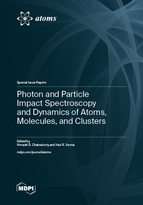Photon and Particle Impact Spectroscopy and Dynamics of Atoms, Molecules, and Clusters
A special issue of Atoms (ISSN 2218-2004).
Deadline for manuscript submissions: closed (31 May 2023) | Viewed by 18463
Special Issue Editors
Interests: theoretical AMO physics; photoabsorption of atoms, fullerenes, endofullerenes; photoemission time delay; relaxation/thermalization of hot electrons in fullerene systems; positronium formation; ion-surface charge transfer collisions
Interests: structure and dynamics of atoms, clusters; photoionization studies of endohedral systems; Wigner time delay studies; electron impact studies on fullerenes
Special Issue Information
Dear Colleagues,
This Special Issue aims to publish new and impactful research on fundamental and advanced studies investigating the interactions of atomic, molecular or cluster systems with radiation or impacting charge particles.
Submissions should present novel effects, mechanisms and phenomena in the energy response (spectroscopy) and the time evolution (dynamics) of excited target systems, highlighting new experimental techniques and powerful theoretical/computational methods and instigating novel questions to motivate future research and collaboration.
There have been three recent developments in AMO and cluster science: a) new and progressively precise technologies to synthesize materials with good purity statistics in gas-phase, as thin films, or in liquid-phase; b) significant diversification of pump–probe laser and particle sources, and related experimental techniques for accessing both the energy response and temporal response in ultrafast time scales of the target materials; and c) increasing availability of high-performance computer software on ever faster computers, processed in series and in parallel modes. These developments have empowered the broader AMO community to address more detailed and critical aspects of response and relaxation processes. As a result, many groups have become involved in ever-more challenging and complex investigations pushing the frontier of knowledge. The planned Special Issue will provide a forum in which to broadcast emerging research results, creating a professional knowledge repository of novel research questions and outlooks, and stimulating brand-new collaborations.
The bulk of topics that this Issue will cover is also published in American Physical Society, American Institute of Physics, Institute of Physics UK and European Physics journals, besides in regular issues of Atoms, a journal published by MDPI. Potential authors will have past and future publications in these journals stemming from their broader programs and collaborations. We hope that the material published in this Special Issue will substantially complement research published elsewhere. In particular, given the open access nature of Atoms, this Issue aims to widen readership through engagement with scientific connections and cross-citations.
Prof. Dr. Himadri S. Chakraborty
Dr. Hari R. Varma
Guest Editors
Manuscript Submission Information
Manuscripts should be submitted online at www.mdpi.com by registering and logging in to this website. Once you are registered, click here to go to the submission form. Manuscripts can be submitted until the deadline. All submissions that pass pre-check are peer-reviewed. Accepted papers will be published continuously in the journal (as soon as accepted) and will be listed together on the special issue website. Research articles, review articles as well as short communications are invited. For planned papers, a title and short abstract (about 100 words) can be sent to the Editorial Office for announcement on this website.
Submitted manuscripts should not have been published previously, nor be under consideration for publication elsewhere (except conference proceedings papers). All manuscripts are thoroughly refereed through a single-blind peer-review process. A guide for authors and other relevant information for submission of manuscripts is available on the Instructions for Authors page. Atoms is an international peer-reviewed open access monthly journal published by MDPI.
Please visit the Instructions for Authors page before submitting a manuscript. The Article Processing Charge (APC) for publication in this open access journal is 1500 CHF (Swiss Francs). Submitted papers should be well formatted and use good English. Authors may use MDPI's English editing service prior to publication or during author revisions.
Keywords
- ultrafast
- attosecond
- femtosecond
- diffraction
- relaxation
- decay
- excitation
- ionization
- fragmentation
- high-harmonic
- endohedral
- plasmonics
- electron collision
- positron collision







